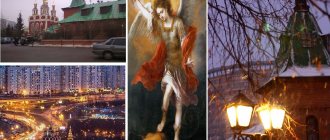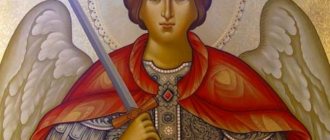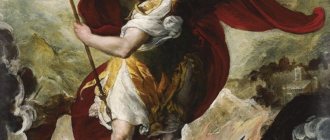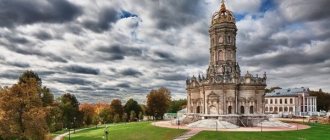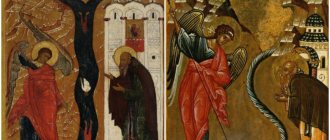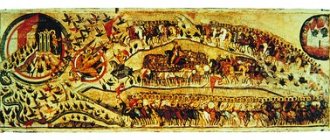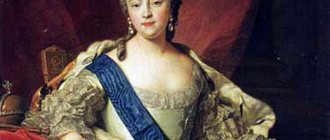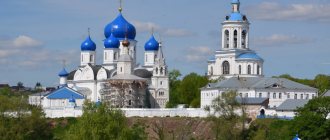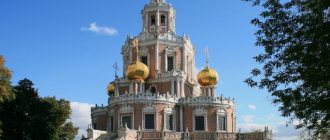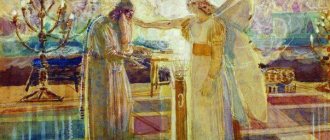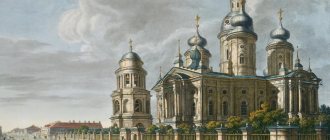Location of the building
The Church of the Archangel Michael on the southwestern outskirts of the capital is known as a solemn building rising above the hill. For several centuries, the spiritual life of the Troparevo region has been focused here.
The village of Tropareva has always been characterized by the liveliness of lively intersections, the roads from which lead in a western direction. This area previously belonged to a merchant whose name was Ivan Tropar. Subsequently, the village began to belong to the Novodevichy Convent. Thus, at the end of the 17th - beginning of the 18th century, the Church of the Archangel Michael appeared on the southwestern outskirts.
Our days
Over time, the village became an urban area. The area was named "Troparevo - Nikulino". The temple is located on the south side of the park on Vernadsky Avenue, 90.
How to get to the Church of the Archangel Michael? To get here, you can use ground transport: buses and minibuses. Depending on which part of the city you get from, you can get off at the “Theater in the South-West” or “Church of the Archangel Michael” stops.
Where is the temple?
The village of Troparevo has always been a lively and busy crossroads of several important roads southwest of Moscow. Once belonging to the merchant Ivan Tropar, after whom it was named, it eventually became the property of the Novodevichy Convent, with whose funds the Church of the Archangel Michael was erected at the turn of the 17th–18th centuries.
- Today Troparevo has entered the city limits, turning into the Troparevo-Nikulino district, and the temple, which is nestled in the southern side of Nikulino Park, has found its modern Moscow address: Vernadsky Avenue, building 90.
- If you have any questions or clarifications, you can call the temple by phone: 8 (495) 4332476.
When are services held?
You can choose the following time to attend the service:
- Liturgy is held daily on weekdays from 8 am.
- Evening takes place at 17:00.
- On Sundays, the liturgy is held twice - early in the morning (at 7:00) and later (at 10:00).
- On Sundays and holidays the sacrament of the All-Night Vigil is celebrated. It starts at 17:00.
In case of some changes in the schedule of services, this information can be found on the official website of the church. Messages are regularly updated. Above in the article the address of the Church of the Archangel Michael on the southwestern outskirts is already indicated.
Many parishioners visit this temple every day, admiring its external and internal decoration and making prayer requests to the Creator.
Social activities
The “South-West” group of alcoholics and drug addicts anonymous was organized at the church.
Group meetings are held on Mondays at 19.00, Thursdays at 20.00 and Saturdays at 18.00 in the Sunday School premises, enter the building, go left down the stairs, first door on the right. You should ask the Temple guards.
- Hotline phone number, website address: www.na-msk.ru
- Social phone number employee: Taktarova Irina Viktorovna 8-915-348-92-47.
Hospital care.
- City Clinical Hospital No. 31 st. Lobachevskogo, 42 Responsible for communication with the medical institution: Taktarova Irina Viktorovna Tel. e-mail
Historical facts
The history of the Church of the Archangel Michael in Troparevo began at the end of the 17th century. The building was created in accordance with the then requirements for the five-domed architectural style. A characteristic feature is that the style combines traditionally Russian forms and new elements, characterized by greater pomp and decorative decoration. Such techniques were borrowed from the architecture of Western countries.
The building is characterized by a symmetrical composition, which consists of the following elements:
- a two-story, five-domed main building (or “quadruple,” as it is also called);
- three-part apse;
- refectory;
- three-tiered hipped bell tower.
Cathedral of Archangel Michael and other ethereal Heavenly Powers. history of the holiday
From the books of the Old and New Testaments we learn about Angels - creatures of the invisible world, messengers of God. Numerous cases of their occurrence have been known to people for a long time. Already in apostolic times, a distorted, heretical opinion arose that one cannot pray directly to Christ, but must turn to the Angels. This heresy, according to Blessed Theodoret, even reached the level of idolatry.
Greatness is a song for the holiday. Pomeranian usage
At the beginning of the 4th century, at the local Council of Laodicea (several years before the First Ecumenical Council), the heretical opinion about angels as creators and rulers of the Universe was condemned. The Council approved the Orthodox veneration of the ethereal Heavenly Powers, and the holiday was established on November 8, on the eighth day of the ninth month - the year at that time began on March 1. This date was not chosen by chance. The eighth day symbolizes the future Council of all Heavenly Powers during the Last Judgment of God, which the holy fathers call the “eighth day,” when “the Son of Man will come in His Glory and all the holy Angels with Him” (Matthew 25:31). The ninth month of the year pointed to the nine ranks of angels. In the festive chant, magnification, the names of the ranks of angels are listed: “We magnify you, Archangels, Angels, Principalities, Powers, Thrones and Dominions, Powers and Cherubim, terrible Seraphim, glorifying the Lord.”
Library of the Russian Faith Teaching on the Council of the Archangel Michael. Great Menaion of Cheti →
Read online in original
Architecture Features
According to the famous historian and local historian M. Ilyin, the general composition of the church in Troparevo-Nikulino is similar to many other ordinary churches of that time.
But its architect wanted to apply some spectacular innovations. This explains the use of techniques and forms of the Moscow Baroque in relation to this structure. So it became more formal, solemn in appearance.
The shape of the bell tower of the St. Michael's Church is a characteristic example of an octagon, which is typical for hipped bell towers of the 17th century. It is created in the form of a centric platform, where a light, small, cut-out window in the form of an octagonal tent is provided.
To date, neither the columns on the pillar supports nor the decorative platbands have been preserved. The bell tower was located as required by the then accepted canons - strictly above the center of the western entrance to the building.
Description of the sights and shrines of the church
From the description of the Church of the Archangel Michael, you can learn that the building is interesting because it combines “rural” and luxurious architecture in an unusual way. After all, the Moscow Baroque (namely, the style of St. Michael’s Church) is characterized by splendor of decoration and a kind of pomp. Therefore, the building fits quite well into the city landscape.
The main attractions of the temple are:
- Onion domes in the amount of five pieces. They have gilded crosses installed on them. The base is decorated with a crescent. Such symbolism can be traced back in Revelation from John the Theologian. Previously, this was how the baptismal font or Bethlehem manger was depicted. This designation can in no way be considered a symbol of the victory of Christians over Muslims.
- The main temple mosaic icon is also an attraction. It is located on the right above the church gate. The mosaic depicts Archangel Michael as the Archangel - the leader of the heavenly warriors. He fearlessly goes to war with evil. With the help of festive red shades, confidence is emphasized that good will triumph and the fallen angel will be defeated.
- Among the variety of revered temple shrines, the “Donskaya” and “Kashinskaya” icons of the Mother of God should also be highlighted. Also here you can see the relics belonging to the holy martyr Harlampius and St. Nicholas.
In addition to those listed, there are many other notable icons in the temple.
Prosperity of the Temple
Over the past few years, the Church of the Archangel Michael in Troparevo has seen prosperity and its further transformation. This can be seen from the renovated domes, sparkling in the sunlight against the backdrop of magnificent nature. The new fence looks strict and solemn. The building acquired a clergy house and a Sunday school. There has been an increase in the number of believers who regularly visit the temple. The church is becoming especially popular.
On the eastern side of the temple, where the church fence is installed, at the exit to Vernadsky Avenue, a memorial plaque appeared on which are carved the names of Troparev residents who died during the Great Patriotic War.
Today, the Church of the Archangel Michael is subordinate to His Holiness the Patriarch of Moscow and All Rus'. According to its status, this is the Patriarchal Metochion. There are known multiple visits of His Holiness Patriarch Alexy II to perform divine services here.
It is known about the rector of the temple, Archpriest Georgy Studenov, that he studied at the Moscow Theological Seminary and the Moscow Theological Academy.
Through the efforts of the abbot, labor and care are invested, the goal of which is to restore the temple. This person is also known as an honorary professor at Moscow Pedagogical University.
The prosperity of the temple was repeatedly reported both in Moscow and all-Russian publications. The church has earned a reputation as a major landmark on the southwestern outskirts of the capital.
Temples in honor of the Archangel Michael
After the Baptism of Rus', the holiday of the Council of Ethereal Powers becomes known to our ancestors. Many churches and monasteries were dedicated to this holiday - St. Michael's Day . The first Archangel Cathedral was built in Kiev immediately after the adoption of Christianity, and a monastery was established there.
Subsequently, many cases of miraculous assistance of the Archangel in military affairs were known. The Volokolamsk Patericon contains a description of the miraculous salvation of Veliky Novgorod from the Tatar army:
Sometimes, by God's permission, it was a sin for our sake, the godless Agaryan king Batu captured and burned the Russian land and went to the New City and God and the Most Pure Mother of God covered it with the appearance of Michael the Archangel, who forbade him to go against it. He went to the Lithuanian cities and came to Kyiv and saw the great Archangel Michael written above the doors of the stone church and said to the prince with his finger: “Forbid me to go to Veliky Novgorod.
It is not surprising that in almost every Russian city there was a temple or chapel dedicated to the feast of the Council of the Archangel Michael and the Ethereal Powers. Perhaps the most famous is the Archangel Cathedral of the Moscow Kremlin , the tomb of the Moscow princes. The original wooden Archangel Cathedral was probably built in 1247-1248, during the reign of Mikhail Khorobrit, brother of Alexander Nevsky. Subsequently, it was rebuilt more than once, and the current cathedral building was built in 1505-1508.
Archangel Cathedral of the Moscow Kremlin
There was also the Chudov Monastery in the Kremlin. The main temple of the monastery was consecrated in honor of the miracle of Archangel Michael in Khoneh (celebrated September 6/19). In 1929-1930 the monastery was destroyed.
In the middle of the 14th century. a wooden temple appeared in the name of Archangel Michael in the city of Kolomna . At this time, in the wall of the wooden fortress of Kolomna, between the Marinkina and Faceted towers, there were already passages of the Mikhailovsky Gate, opposite which the Mikhailovskaya (or Arkhangelskaya) settlement was located. After the Time of Troubles, the temple fell into disrepair. In 1700, the stone Church of the Archangel Michael with the chapel of the Three Saints was built. The currently existing stone church of the Archangel Michael received its modern appearance by rebuilding parts of the previous stone church.
Temple in the name of Archangel Michael in Kolomna
It was believed that Archangel Michael is the patron saint of the Russian army. St. Michael the Archangel Cathedral in 1221 . Subsequently, it was rebuilt several times. The current cathedral building was built in 1628-1631. in memory of the Nizhny Novgorod militia.
Archangel Cathedral of the Nizhny Novgorod Kremlin
It is also worth mentioning that the banner of the Nizhny Novgorod militia depicts Archangel Michael in military armor and Jesus Navvinus bowing before him.
Banner of the Nizhny Novgorod militia that liberated Moscow in 1612
Beyond the Siversov Canal, a little south of Nereditsa, near Seltso-Shaterno, Novgorod region, there are the remains of the stone temple of the Archangel Michael in the Skovorodsky Monastery . The founder of the monastery and the builder of the stone temple was the Novgorod ruler Moses (1324-1329). The Church of the Archangel Michael was built by order of Archbishop Moses in 1355. In its architectural forms, the St. Michael's Church was close to the Volotovo church near Veliky Novgorod. The laconicly designed facades of the building, which did not even have blades, ended with a three-blade zakomara. The volumetric composition was complemented by porches from the north, west and south. Leaving the department in 1360, Archbishop Moses retired to the Skovorodsky Monastery, where he died and was buried on January 25, 1362. In the XVIII-XIX centuries. the temple was repaired several times, supplemented with extensions, received a new roof, and instead of the original one dome, it was crowned with five domes. The temple was practically destroyed during the Great Patriotic War.
Ruins of the St. Michael the Archangel Church of the Skovorodsky Monastery near Seltso-Shaterno, Novgorod region
A temple in Veliky Novgorod was consecrated in the name of Archangel Michael . The wooden church of the Archangel Michael in Torg has been known since the 12th century. Later the church was built in stone. The church was rebuilt in the 14th-15th centuries, and the northern gallery was erected in the 16th century. By the beginning of the 19th century, the Church of the Archangel Michael was a ruin. In the second half of the 19th century, the upper part of the building was restored with new materials in the architectural forms of the time. In the lower part, foundations and wall masonry from the 14th-15th centuries have been preserved.
Temple in the name of the Archangel Michael in Veliky Novgorod
In the name of the Archangel Michael, a temple was consecrated in the village of Kobylye Gorodishche, Gdov district, Novgorod region . The temple was built in the 15th century. The thick walls of the temple are made of slabs. A “tribune” or lantern rises above the building, surrounded at the top by several rows of scars and squares; they are terminated by a series of concentric semicircular depressions. On the lantern there is a pear-shaped head, initially covered with wood chips and later with iron. Two pillars separate the altar from the church, and two are connected by an arch to the walls. Above the arches there are windows, some span, and some solid. The altar is separated from the altar and sacristy by walls with narrow spans. Currently, the Church of the Archangel Michael is an active temple of the Russian Orthodox Church.
Temple in the name of the Archangel Michael in the village of Kobylye Gorodishche, Gdov district, Novgorod region
The cathedral in Ryazan was consecrated in the name of Archangel Michael . The first mention of the Archangel Cathedral dates back to the end of the 15th century. Since 1756, it was noted in the scribe books that the cathedral church had fallen into such disrepair that it was no longer possible to serve in it. For many years, services in the cathedral ceased, but through the efforts of Archbishop Sergius, repair work began in the Archangel Cathedral. In 1819, the temple was completely ready to once again receive parishioners. During Soviet times, the cathedral, like many churches in Russia, was closed. His property was requisitioned. The interior was gradually destroyed. Nowadays, the cathedral houses an exposition of the Ryazan Kremlin Museum.
Temple in the name of the Archangel Michael in Ryazan
In the name of Archangel Michael, a temple was consecrated in the city of Slobodskaya, Kirov region . The church was built in 1610. It is known that the design of the roof was such that it did not allow the penetration of moisture and rotting of wooden parts, and the building itself was built with the expectation of natural ventilation of the walls. It was part of the complex of the Epiphany, later Holy Cross Monastery, founded in 1599 on the outskirts of the city. At first, this building served not only as a church, but also as a fortress tower with a gate through which one could enter the monastery, and through loopholes in the walls one could shoot back from the enemy. The small wooden church was inconspicuous compared to the buildings of the monastery and did not attract attention. Nowadays, a unique collection of wooden temple figures is exhibited in the Archangel Michael Church - the only one in the Kirov region.
Michael the Archangel Church in Slobodskaya, Kirov Region
In the name of the Archangel Michael, a temple was consecrated in the village of Andreevshchina, Lodeynopolsky district, Leningrad region . The temple was built in 1613. Description of St. Michael's Church given in the News of the Imperial Archaeological Commission: “In 1848, a foundation of wild stone was laid under the church, and its walls were lined with planks. Height 11, length 9 1/3, width 2? soot The windows are small, square, three lights. The ceiling is covered with a Christmas tree. There is no salt. The iconostasis is old, in chapels, in 4 tiers, with old icons. The revealed icon of St. St. Nicholas the Wonderworker, found in the ground near the place where the landowner Andrei Zavalishin lived, monastically the Venerable Andrian Andrusovsky, whose relics rest in the Andrusov Hermitage. Birch bark wedding crowns are kept in the church. The church has given a significant slope on the western side. In 1913, its renovation was allowed.” The church is currently lost.
A temple in the name of the Archangel Michael was consecrated in the village of Andreevshchina, Lodeynopolsky district, Leningrad region
, the cathedral on the Mikulin settlement in the Lotoshinsky district of the Moscow region was consecrated . The cathedral was built in the late 1550s. in the center of the ancient settlement of the Tver princes, surrounded by earthen ramparts about 5.5 meters high and 600 meters in circumference. The fortress, well fortified and surrounded by high ramparts with a fortress (a wall of logs), served as an outpost of the Tver Principality during its rivalry with Moscow. An older cathedral built in 1398 stood on the site of the current one. The present temple was originally built as the tomb of Prince S.N. Mikulinsky, who inherited the estate from his ancestors, appanage princes. A basement was made under the cathedral, in which the tomb was located. When the cathedral needed to be strengthened at the end of the 18th century, the crypt was filled up. The huge four-pillar temple was originally five-domed, with a roof covering, it was built of half-rubble brick, that is, the outer and inner parts of the wall were lined with brick, and the space between them was filled with broken stone and filled with mortar. The facades of the cathedral are divided by blades into three parts (spreads), ending in wide zakomaras. In the middle of the three facades there are huge perspective portals, which from a distance seem like very small doors. In 1886-1887 The ancient building has undergone another restoration. During Soviet times, the temple remained closed since 1922. Currently, the temple belongs to the Russian Orthodox Church, and weekly services are held there.
Cathedral in the name of the Archangel Michael on the Mikulin settlement in the Lotoshinsky district of the Moscow region
In the name of Archangel Michael, a temple was consecrated in the village of Synkovichi, Grodno region of the Republic of Belarus . The date of construction of the temple is considered to be 1407. The architecture of the temple clearly shows features characteristic of the Gothic style, as well as details of ancient Russian architecture. It is known that in 1880-1892. The temple was reconstructed - the roof was replaced, a vestibule and a dome were built over the apse, the dome over the central part of the temple was dismantled, and a rubble-brick two-tier tetrahedral bell tower was erected. After World War II the church was closed. The activity of the temple was resumed in 1992.
Michael the Archangel Church in the village of Synkovichi, Grodno region of Belarus
In the name of the Archangel Michael, a church was consecrated in the village. Chesniki, Ivano-Frankivsk region of Ukraine . The stone church is built of limestone, three-faced, with a rectangular nave and baba and a faceted five-walled eastern volume. The church is covered with three domes without drums. The finished roof over the nave has the appearance of a square top with two creases; the side rooms are covered with a plastic pitched shingle roof. The smooth planes of the walls are devoid of decoration and are enlivened only by low entrance openings on the western and southern facades with small windows above them. In the 19th century, the northern and southern facades were strengthened with powerful buttresses.
Temple in the name of the Archangel Michael in the village. Chesniki Ivano-Frankivsk region of Ukraine
In the name of Archangel Michael, a church was consecrated in the city of Svalyava, Transcarpathian region of Ukraine . The church dates from 1588. The church acquired its modern appearance during a major reconstruction in 1759. The wooden church was built from oak beams. The walls of the tower are covered with shingles, the roofs and walls are covered with ploughshares. Consists of three different-wide log houses. Each log house is covered with a separate roof, but they are perceived as fused together thanks to the soft transition of the nave floor into the roof of the eastern part and the common roof of the porch and babinets, which accentuates the entrance. The submission is based on the release of the crowns of the log houses. The roofs of the eastern part and the nave are topped with small square turrets with onion-shaped domes with hipped aprons. Under the roof of the nave, one hall of the log house has been preserved, the second has been converted into a box vault. The church was restored in 1972.
Temple in the name of the Archangel Michael in the city of Svalyava, Transcarpathian region of Ukraine
In the name of Archangel Michael, a church was consecrated in the city of Oster, Chernigov region of Ukraine . The church was built in 1098 by Vladimir Monomakh, possibly as the church of the princely castle “Gorodok na Vostra”. It was probably part of the castle's earthen-wooden fortification system. In 1195, the son of Yuri Dolgoruky, Vsevolod Yuryevich, restored the Church of St. Michael the Archangel. In 1753, the wooden top was burned by lightning, and the masonry began to collapse as a result of the hill shifting towards the river. But no money was found for major repairs, and the temple continued to deteriorate. At the end of the 18th - beginning of the 19th centuries. the ruins of the church were dismantled, leaving the apse and part of the south-eastern wall. It was only in 1907 that the first conservation of the remains was made. Only a semicircular apse has survived to this day, the inner radius of which is about 3 meters, and a small part of the wall on the south side.
Temple in the name of the Archangel Michael in the city of Oster, Chernihiv region of Ukraine
The Vydubitsky Monastery in Kiev was consecrated in the name of Archangel Michael . The monastery was founded around 1070 by Vsevolod Yaroslavich in the Vydubychi tract, near the Dnieper crossing and his personal castle residence - the Red Court. The main temple of the monastery was the Church of the Archangel Michael. To save the monastery church from landslides, a grandiose retaining wall was built in 1199. After the Union of Brest, the monastery passed into the hands of the Uniates from the Basilian Order. The old monastery cathedral of the Miracle of the Archangel Michael in Khoneh collapsed into the Dnieper in the middle of the 16th century. In 1555 it was rebuilt by Abbot Klimenty Starusich. In 1637, the Church of St. Michael the Archangel was restored. The monastery was liquidated in 1924. The churches were still active until the 1930s, when their iconostases were burned and the cemetery was destroyed. The buildings of the former monastery were handed over to the workers and employees of the woodworking plant on Telichka. In 1967-1982. restoration of the buildings was carried out. In 1975-1997 The Institute of Archeology was located here. The monastery resumed its activities in 1992. In 1996, the government completely returned the Vydubitsky Monastery to the Church (UOC-KP).
Temple in the name of the Archangel Michael of the Vydubitsky monastery of the same name in Kyiv
Let's sum it up
The Church of the Archangel Michael on the southwestern outskirts of Moscow is an ancient building that previously belonged to residents of the village of Troparevo. Over time, this area became one of the urban areas. You can easily get here by buses and minibuses from any part of the capital.
Among the attractions of this church, the mosaic image of the Archangel Michael, boldly coming out to fight the forces of darkness, stands out. Various images of the Virgin Mary are also kept here.
The temple owes its current prosperity to rector Georgy Studenov, through whose efforts the church is being rebuilt and becoming even more beautiful. The atmosphere of the church ensures its popularity among parishioners.
